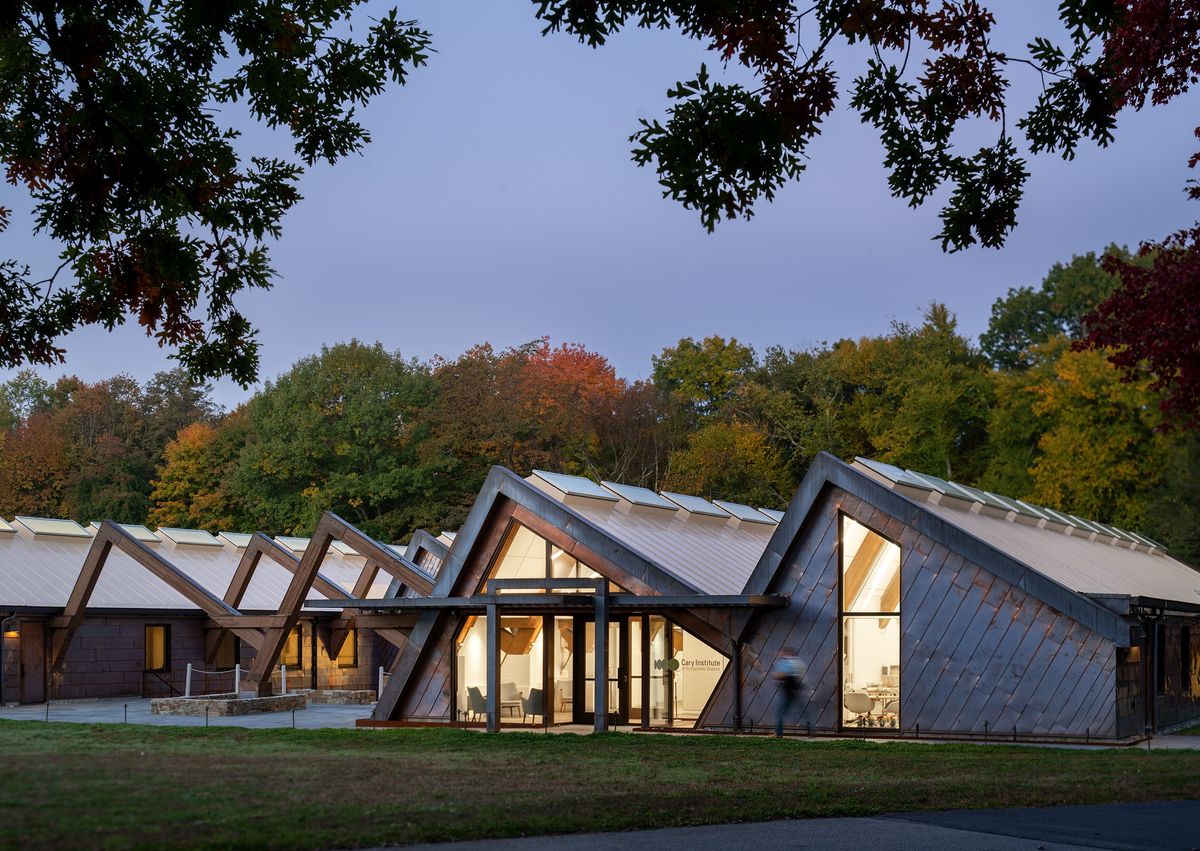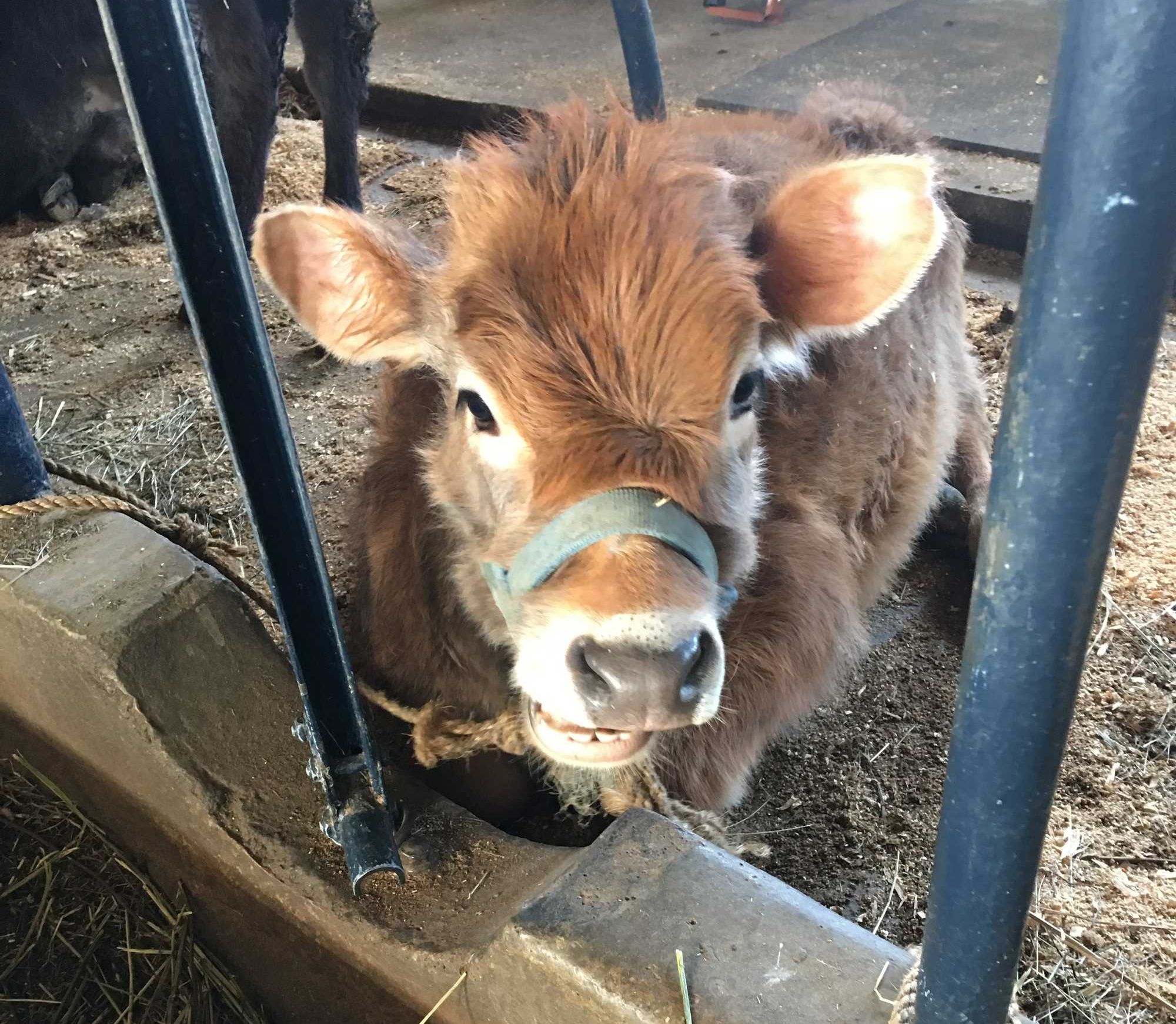Exploring eco-science at the Cary Institute

The Cary Institute’s headquarters, the Tozer Ecosystem Science Building, at dawn.
Courtesy Cary Institute of Ecosystem studies/Photo by Seamus Payne

The Cary Institute’s headquarters, the Tozer Ecosystem Science Building, at dawn.
Cary Institute of Ecosystem Studies is well known in Millbrook and the area surrounding it for its 2,000 acres of nature walks, trails, ferns and plants as well as its many forums and presentations.
Over the past few years, the institute was completely renovated. There are new buildings clad in copper; a courtyard; and progressing nicely, a field of native pollinating plants.
What is most important about Cary, however, is what we don’t see: the work that goes on in labs, in fields and streams, not just in this area but across the world. President Joshua Ginsberg is justly proud that Cary is a force behind much of the research concerning important ecological issues of the day and how that research can impact local, state, federal and international laws and decisions.
It is difficult to prioritize Cary’s research and contributions to science and the environment; all of the projects are important.
Cary was founded in 1983 by Gene Likens, the co-discoverer of acid rain in North America. His research and experiments on precipitation and chemistry in streamwater, carried on in the 1960s at the Hubbard Brook Experimental Forest, became the foundation in shaping environmental legislation. He was an advisor to governors in New York, New Hampshire and Connecticut as well as advisor to a U.S. president and the author of 26 books and more than 600 scientific papers, and was awarded the National Medal of Science by President George W. Bush in 2001
His research strongly influenced the Clean Air Act Amendments of 1990, which greatly expanded federal control of toxic air pollutants. To this day, Cary is known for having the longest running continuous data set on acid rain.
Invasive insects
Cary was instrumental in taking the initiative on researching invasive forest pests that come into the U.S. by various means. The late Cary scientist Gary Lovett perceived the problem of invasive species early on; New York state had the more new invasive pests in their forests than any other — 62 types were discovered in the state. These pests, such as the Asian long-horned beetle, discovered in 1996 in Brooklyn, the hemlock woolly adelgid, the emerald ash borer and others, come in through international trade, in lumber and packaging and in live trees and plants.
Scientists sought to strengthen laws regarding the problem, and brought attention to it in highlighting the Agricultural Improvement Act of 2018. Yet the problem persists; just recently in this area, there was a huge problem with the spongy moth and the spotted lanternfly.
Lovett was concerned that not enough was being done and a set of science-based policies were developed, and recommendations made, to block the importation of insects and diseases brought in through international trade systems. Cary scientists, along with others, continues to work with legislators and through partnership to implement Tree-SMART Trade legislation.
A petition was started April 8, 2022, to ask Congress to do something about it. With Lovett and Cary Institute spearheading the petition, it was delivered with over 1,700 signatures to the House and Senate agricultural committees, requesting action be taken in the form of a congressional hearing on these invasive forest pests. On April 4, 2023, a bill was introduced to the Committee on Agriculture, Nutrition and Forestry for action by the Senate.
Foliage fans
Cary scientists understand the importance of trees in ecology. They are studying the impact of forest fires on our ecological system. They conduct research in the U.S. and around the world.
When rain forests below the equator are burned or plundered, we lose all the potential medicines and other undiscovered treasures that they’re hiding.
Trees produce shade, which cools temperatures, and they release water vapor through their leaves. This also helps cool the air. This has an effect on energy costs for the consumer. With three carefully placed trees, a homeowner can save $100-$250 yearly on energy costs, according to the U.S. Department of Energy.
Trees absorb carbon dioxide, releasing the oxygen back into the air and storing the carbon. This helps in reducing the effects of climate change. A mature tree can absorb 48 pounds of carbon dioxide and will provide oxygen in its place.
Animals also benefit from trees, as a source of both shelter and food. Trees produce fruits and nuts, as well as some spices, which we use daily, and provide lumber for building.
Water protection
Water is an element we can’t live without. Emma Rosi, recently retired from Cary, studied how failing wastewater infrastructure plays a part in polluting streams and creating antibiotic-resistant “superbugs.” Rosi’s research showed how prescription and illicit drugs that invade our waterways impact freshwater quality and the aquatic life it should support.
After earning her master’s and doctoral degrees at the University of Georgia, Rosi took on a leading role in the area of freshwater science and researching how emerging contaminants shape these systems. She has served on the U.S. Environmental Protection Agency’s Science Advisory Board.
Disease prediction
Joining the Cary Institute in 2014, Barbara Han got her doctorate in zoology from Oregon State University. Her research involves ecology, global health and computing, all of which she uses to predict outbreaks of new zoonotic diseases, the ones that jump from animals to humans. Of the many cases reported each year — over 1 billion — most can be attributed to zoonotic pathogens.
Han has partnered with collaborators at IBM and NASA on predicting global disease and has also helped the U.S. government and the World Health Organization to apply this specialized research to disease prevention.
Lyme prevention
Richard Ostfeld and Cary Institute partnered with Bard College, the Centers for Disease Control and Prevention, the New York State Department of Health and the Dutchess County Department of Behavioral and Community Health on The Tick Project, a five-year study that began in 2016 to find out if neighborhood-based prevention would have an effect on the amount of cases of Lyme and other tick-borne diseases were contracted.
Simple methods believed to be safe for the environment were used on both humans and pets. Twenty-four neighborhoods were chosen to participate, each consisting of 6 to 10 blocks. They used bait boxes to catch rodents and MET52 insecticide spray. The number of ticks in the yards with bait boxes was reduced to about half the usual number, while the spray had no effect on the number of ticks found. Neither method had an effect on people’s incidences with ticks, but pets’ diseases from tick-borne infection was lower by about 50% in yards using either the traps or the spray.
Cary is a nonprofit. Its website at caryinstitute.org includes forums, scientific papers, biographies and notes on its scientists as well as a place to donate.
The Stone Round Barn at Hancock Shaker Village.
My husband Tom, our friend Jim Jasper and I spent the day at Hancock Shaker Village in Pittsfield, Massachusetts. A cold, blustery wind shook the limbs of an ancient apple tree still clinging to golden fruit. Spitting sleet drove us inside for warmth, and the lusty smells of manure from the goats, sheep, pigs and chickens in the Stone Round Barn filled our senses. We traveled back in time down sparse hallways lined with endless peg racks. The winter light was slightly crooked through the panes of old glass. The quiet life of the Shakers is preserved simply.

Originally founded in England, the Shakers brought their communal religious society to the New World 250 years ago. They sought the perfection of heaven on earth through their values of equality and pacifism. They followed strict protocols of behavior and belief. They were celibate and never married, yet they loved singing and ecstatic dancing, or “shaking,” and often adopted orphans. To achieve their millennialist goal of transcendental rapture, we learned, even their bedclothes had to conform: One must sleep in a bed painted deep green with blue and white coverings.
Shakers believed in gender and racial equality and anointed their visionary founding leader, Mother Ann Lee, an illiterate yet wise woman, as the Second Coming. They embraced sustainability and created practical designs of great utility and beauty, such as the mail-order seed packet, the wood stove, the circular saw, the metal pen, the flat broom and wooden clothespins.
Burning coal smelled acrid as the blacksmith fired up his stove to heat the metal rod he was transforming into a hook. Hammer on anvil is an ancient sound. My husband has blacksmithing skills and once made the strap hinges and thumb latches for a friend’s home.
Shaker chairs and rockers are still made today in the woodworker’s shop. They are well made and functional, with woven cloth or rush seats. In the communal living space, or Brick Dwelling, chairs hang from the Shaker pegs that run the length of the hallways, which once housed more than 100 Shakers.

In 1826, the 95-foot Round Stone Barn was built of limestone quarried from the land of the 3,000-acre Hancock Shaker Village. Its unique design allowed a continuous workflow. Fifty cows could stand in a circle facing one another and be fed more easily. Manure could be shoveled into a pit below and removed by wagon and there was more light and better ventilation.
Shakers called us the “people of the world” and referred to their farm as the City of Peace. We take lessons away with us, yearning somehow for their simplicity and close relationship to nature. One Shaker said, “There’s as much reverence in pulling an onion as there is in singing hallelujah.”
A sense of calm came over me as I looked across the fields to the hills in the distance. A woman like me once stood between these long rows of herbs — summer savory, sage, sweet marjoram and thyme — leaned on her shovel brushing her hair back from her eyes, watching gray snow clouds roll down the Berkshires.
More information at hancockshakervillage.org

Exterior of Lakeville Books & Stationery in Great Barrington.
Fresh off the successful opening of Lakeville Books & Stationery in April 2025, Lakeville residents Darryl and Anne Peck have expanded their business by opening their second store in the former Bookloft space at 63 State St. (Route 7) in Great Barrington.
“We have been part of the community since 1990,” said Darryl Peck. “The addition of Great Barrington, a town I have been visiting since I was a kid, is special. And obviously we are thrilled to ensure that Great Barrington once again has a new bookstore.”
The second Lakeville Books & Stationery is slightly larger than the first store. It offers more than 10,000 books and follows the same model: a general-interest store with a curated mix of current bestsellers, children’s and young readers’ sections; and robust collections for adults ranging from arts and architecture, cooking and gardening, and home design to literature and memoirs. Anne reads more than 150 new titles every year (as many as a Booker Prize judge) and is a great resource to help customers find the perfect pick.
A real-time inventory system helps the store track what’s on hand, and staff can order items that aren’t currently available. There is also a selection of writing and paper goods, including notecards, journals, pens and notebooks, as well as art supplies, board games, jigsaw puzzles and more. The owners scour the stationery trade shows twice a year and, Darryl says, “like to tailor what we offer to suit the interest of our customers in each market.”
The Pecks know what it takes to run a successful local enterprise. Darryl has a 53-year background in retail and has launched several successful businesses. He and Anne owned and operated a bookstore on St. Simons Island, Georgia, from 2019 to 2025. They are tapping into their local roots with both stores. They raised their family in Sharon, and their daughter Alice, a native of the Northwest Corner, manages the Lakeville store.

The family values the role that a retail store plays as a supporting partner in the community, and they prioritize great management in both locations, hiring and training talent from local communities. Their 10 team members across both stores are from the area, and two of the Great Barrington employees previously worked at Bookloft.
Darryl and Anne’s attention to customer service is everywhere apparent and adds to the enjoyable and irreplaceable in-store shopping experience. The books are in pristine condition, eliminating the risk of damage that sometimes occurs during shipping. This is especially important for books that will live on people’s shelves and coffee tables for years.
Darryl says, “People love the in-store discovery — you find books you didn’t know existed, which is very difficult to do on a website. Also, many customers depend on our recommendations when visiting. There is a saying about bookstores versus online ordering: We may not have exactly what you were looking for, but we have what you want.”
Lakeville Books & Stationery’s Great Barrington store is open 7 days a week, Monday-Saturday, 10 a.m. to 6 p.m., and Sunday, 11 a.m. to 5 p.m. Parking is available in the lot behind the building and in the parking lot behind the firehouse. The entrance to the store is accessible from the store parking lot.
For more information, go to lakevillebooks.com., and sign-up for the Lakeville Books newsletter.
Richard Feiner and Annette Stover have worked and taught in the arts, communications, and philanthropy in Berlin, Paris, Tokyo and New York. Passionate supporters of the arts, they live in Salisbury and Greenwich Village.